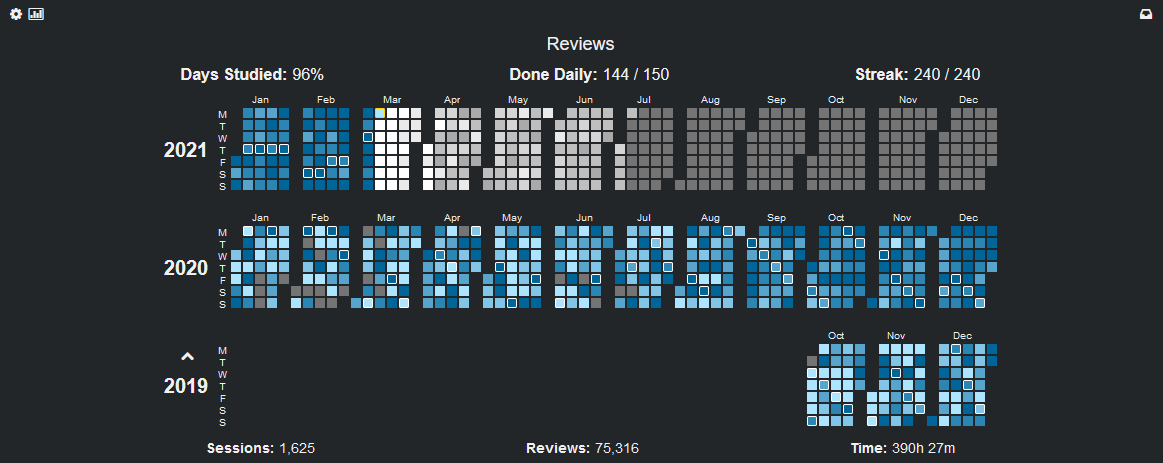Today marks the end of a journey of 523 days (1 year and 5 months ish) since I started WaniKani back in October '19. It has been a heck of a ride, and a very warm refuge in this currently-upside-down world. Special thanks to the lovely people in the POLLs, but also to everyone that has contributed to make this community a positive place, whether you have interacted with me directly or not; you never know who you might have influenced with your words or advice. Thank you!

A little bit about my Japanese journey
I started learning Japanese in 2014 in a language school, where I spent three years. In that span, we went through Minna no Nihongo 1 and half of Minna no Nihongo 2. The school was very nice and the people I met were awesome. I had the chance to spend 10 days in Japan in 2016 with a couple of classmates and our teacher and I absolutely loved it. Ambitious of me, the fourth year I thought the pace had been rather slow and I decided to quit the school to start studying by myself. Initially the plan went very good, I finished the remaining half of Minna no Nihongo 2 and I bought Tobira to continue afterwards. And I did, but only for a little while. Not being in the amazing and positive environment that I was in before started growing on me, and I progressively started not doing much if at all. I tried starting Tobira a few times more over time, but I would never go past lesson 4. I had lost direction and therefore didn’t have much motivation to study on my own. The school was easy because you didn’t need to think about your programme, you just followed it. But having to constantly curate and decide what you need to study and when requires a much more diligent mindset.
Even though I was always interested in Japanese culture and my hobbies kept revolving around it some way or another, this continued on and off for a couple of years. I never stopped indirectly reviewing things I had already learned, and I never really gave up, but I was going nowhere with no clear goal. I had no idea where I wanted to go with my Japanese. When I was in the school I had the clear goal of becoming a translator, and I still think about it nowadays but leaving the school was a big hit. The funny thing is that, turns out, the school programme was 8 years for N2 level, and If I had kept going there, I would have had a much higher proficiency than I currently do. And not only that, the school taught all four disciplines (writing, reading, listening and speaking) so it is effectively even more than what the actual JLPT diploma offers (no speaking, no writing). It is a slow pace, but I’ve come to realise that sometimes what seems faster doesn’t necessarily end up being faster in the end; often times, slower and steady takes you much farther.
I had already learned around 1000 Kanji before discovering WaniKani, and since I needed a good review of them anyway, I started it. It was a breeze in the beginning because I already knew all of the first levels’ kanji and their vocabulary, but I liked the ordering because I started learning new kanji relatively soon so I never really felt like I was wasting money. Overall it has been a wonderful journey, with tiny bits of burnout periods since the early 40s and the expectatives of reaching 60 when I got to the 50s.
What I liked about WaniKani
-
The gamification helps keep you engaged. Ultimately you’re here to learn Japanese, but I’m sure 2055 kanji would look daunting if they were not divided into very small chunks. Gaining a new level was motivating.
-
There are a lot of mnemonics that have been really beneficial in the learning process. I tend to forget every mnemonic past Guru or something, but they have served me well in that initial Apprentice period. Congratulations on coming up with SO many thousands of mnemonics, it’s a massive feat.
-
The staff is amazing. Really easy to reach out to, really eager to keep improving their product, posting in the forums. I only reached out once with the communication feature to notify a bug, but they were really quick in response and they were already working on it. Thank you WK staf!!
-
The community is awesome. Even though I’ve seen a few rotten apples in my journey here, the vast majority of the interactions have been really positive. I like that there’s discussion of anything, and not necessarily beginner-oriented when it comes to Japanese doubts. There are some highly proficient individuals in here, there’s a place for everyone.
-
It’s great that people can make scripts that enhance the WK experience. I have used some that I think is criminal not to use, and others that simply make your journey a much better experience. More on this later.
-
The fact that it actually, effectively teaches you 2055 Kanji and exposes you to 6000 words.
What I found mildly annoying
-
Inconsistency in the meaning the kanji ask for. I noticed that the meaning a kanji asks for is normally a verb, and sometimes it’s a noun. At times, when I introduced for example “examination” instead of “examine”, it was marked as correct with the message of being slightly off, but with other kanji it was marked wrong. A very easy way to solve this is by adding synonyms straight away when you learn them. But many times I thought, why not include both verbs and nouns if it’s the same concept? Other kanji definitely have both the verb and noun.
-
I thought some reading mnemonics were misleading. For example, a recent one is 憧 (long for), and the reading mnemonic says: "No matter how much you long for it, you can’t go back because a cougar (あこが) is in the way. […] " . Unless I’m pronouncing cougar the wrong way (I’m not a native English speaker), I’m inclined to think of the reading as あくが instead of あこが. This happened some other times.
-
The mnemonics with 4 or 5 radicals put together for kanji that are just a combination of two different kanji almost never worked. Too much mental gymnastics, and some of those stories never made sense to me. A story with a radical + kanji would have been much much more effective, although I’m aware that WK teaches strictly with radicals, and some of those kanji are never made into a radical.
Scripts I have used and recommend
These scripts are the ones I have used, and I’m not aware if some are outdated, or better/new ones have come out, so forgive me if that’s the case!
- Keisei Semantic-Phonetic Composition, by Acm. This script is the single best thing I could have installed to complement my kanji learning with WaniKani. It automatically made hundreds of (reading) mnemonics unnecessary. It lets you easily associate certain components to certain readings, even if there are still some exceptions. It’s the same as what WK teaches with 工: I could learn dozens of mnemonics for every kanji that uses 工, or I could just know that there’s a really high chance that mnemonics using this component will be pronounced こう. Seriously, amazing script.
-
Reorder Ultimate 2, by Rfindley. This one lets you override the default order of WaniKani. I have used this to do radicals and kanji after leveling up, while completing any remaining previous level vocabulary in-between levels. It has let me divide lessons of 10 kanji + 10 vocabulary, etc, without the need to clear all the batch of kanji before unlocking vocabulary. I rarely did more than 10 kanji a day, but it still let me keep a pace of 20 items a day. It can also be abused, so absolutely don’t use this to avoid learning vocabulary. Vocabulary is what makes the kanji stick, so know that if you skip it you’re just filling a leaky bucket. Enforce yourself a rule of not having vocabulary more than a level behind. It can be amazing if properly used.
-
WaniKani Heatmap, by Kumirei. It lets you see your trajectory of reviews and lessons until now, and also preview the forecast of upcoming items. It puts things into perspective and lets you plan more efficiently, very nice one!
-
Katakana Madness, by Miaka. It changes every kanji on’yomi from hiragana to katakana. This is conventional, but dictionaries normally use katakana for the on’yomi readings of kanji. This means that for 目 for example, the on’yomi will be shown as モク instead of もく, and the kun’yomi will still be shown as め. When a vocabulary word such as 目次 comes, the answer will still be in hiragana, もくじ. But if the 目 kanji comes for review alone (pink item), when you insert “moku” it will be shown as katakana. This helps not only to move rapidly through dictionaries but also to practice katakana whenever possible.
-
WaniKani Pitch Info, by Invertex. This one displays a little graph with the pitch accent pattern of the word you’re learning. Standard pitch accent is sometimes disregarded, but I think it’s a very important characteristic of the language, and something to be aware of. Maybe it isn’t something you should spend hours and hours studying, but I think it’s beneficial to at least know that the same combination of hiragana can change in meaning depending on where their pitch rise or fall. It has some discrepancies with WK pronunciation in some words, but not many.
-
2 Cool 4 Progress, by Pep95. It allows you to check your progress percentages, like how much of WK you have burned, how much is enlightened, etc.
-
WaniKani Show Specific SRS Level in Reviews, by Seanblue. It shows Apprentice 3, or Guru 2, etc, when you do reviews. It’s nice to know where an item falls, especially when you’re tracking kanji to level up.
Random advice to the lower levels
Please take these recommendations with a grain of salt. I am in no way an expert of Japanese. I’m just an intermediate learner that happens to know a lot of kanji but that’s it. I will write these as if I’m telling them to my recently-started WK self, so please excuse the authoritative tone ![]() .
.
-
WaniKani is a tool to learn kanji. Kanji is only one aspect of the Japanese language, but knowing kanji doesn’t necessarily mean that you know Japanese. As much as I love WaniKani, don’t expect it to be your only resource. You will still have to learn grammar, listen a lot, read a lot, and (yes) learn much more vocabulary. The vocabulary it teaches is good to reinforce the reading of the kanji, but it’s not specifically aimed at making you fluent.
-
Try not to learn too many items a day. It feels tempting to clear your +100 lessons the same day you level up, but know that they will come bite you not only soon, but also much later in your learning when those items are ready to burn. Having spikes of many more reviews on top of your average daily amount is no bueno. If you want to go faster, set a moderate daily lesson amount (like 20) and make use of the Reorder script when you level up to mix your lessons.
-
Try to keep a reasonable number of apprentice items. The generally considered sweet spot is below 100 Apprentice items and it’s the same for me. You can certainly go up, but this will increase your daily reviews and also the items in your short term memory, potentially affecting your retention rate. Play with numbers a bit to know your sweet spot, where you can manage to have a high retention rate (+90% is ideal IMO).
-
Don’t be afraid to use scripts, they are just tools to customize your learning. Make use of them to your advantage. You are not cheating the system (unless you clearly are), you’re making your learning more efficient.
-
Write the kanji even if you don’t expect to communicate through handwriting. It reinforces your link to that kanji and boosts your recognition, making the learning much easier.
-
Try not to dedicate all your Japanese time to WaniKani. It’s easy to go through the motions of an SRS that does all for you; I know I’m guilty of that. But languages are to be enjoyed. Keep improving your proficiency of the language in other aspects, don’t neglect grammar. It is very frustrating to be way ahead in Kanji but not being able to understand much of what you read because you can’t make sense of the syntax, or the grammar constructions.
-
Engage in the community if you can. It makes the learning much more enjoyable when you have similar-minded peers that are struggling and enjoying the same journey. Join a “race to 60” thread, but don’t let it fool you by its name. It’s not actually a race other than with yourself, and everybody shares a bit of their struggles and get encouragement. And they don’t actually need to be to level 60, you can put any goal you like. I recommend Marifly’s Let’s Climb Tokyo Skytree thread, it’s ridiculously active.
-
Try to use the language in any little way you can, up to your capacity, whether it is writing a philosophical essay on life, or posting “good morning, the weather is amazing today” on Hellotalk/wherever. Try to have small victories that show you that not everything is studying. You understood a little passage of a song of your favourite artist? Congratulations, you’re learning! You understood a pun that got lost in translation? Congratulations!! You’re starting to understand bigger and bigger parts of a podcast you’re listening? Amazing stuff. Try to keep these little wins in the foreground.
-
It is OKAY to take breaks. Whatever you need to avoid burnout, it’s better to take a break of two weeks than to burn out for two months. I didn’t need many breaks in my WK journey but know that I will do nothing for one or two weeks. I’ve had a bit of burnout at times that I could have avoided just taking a few days of rest. Seriuosly, take them. This can mean not doing lessons for a few days.
What is next after WK?
For now I will rest for a couple of weeks just doing reviews, but once I resume my Japanese journey I will be focused on completing the Tobira textbook diligently. I am fortunate to have a Lang-8 account from many years ago (new sign-ups are discontinued at the moment unfortunately) so I will try to start writing a lot there; the community is small but it’s still thriving.
I would really like to start speaking as well, I want to be proficient in speaking too. But I’m actually a shy person so actually speaking to people 1 on 1 takes a lot. I don’t know how I’m going to do it, but I would like to. I will look into booking classes on Italki at some point as well to help solidify everything.
Other than that, I want to start listening to the massive archive of podcast that is already Nihongo con Teppei; I’m at a level where I can understand much of what he says. I will also still use SRS, most likely Anki, to add new words that I learn through context, but it will be much more focused and relaxed than WK. I’m using BunPro too so that as well.
And last but not least, I want to keep using these forums. I want to jump on reading much more frequently now that I’m done with WK, so that means I will try to make frequent use of the Book Clubs. I’m already slacking a lot on 君の名は. We’ll see!
Thanks for reading!
終わり














